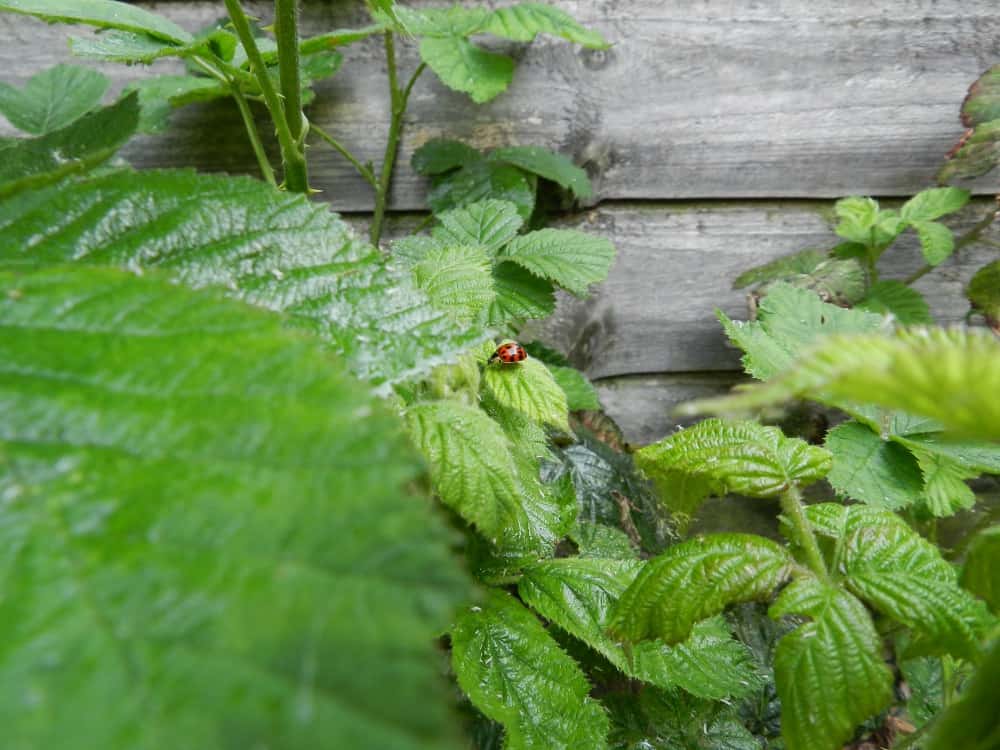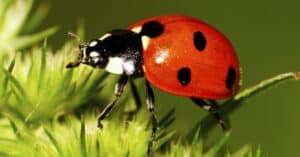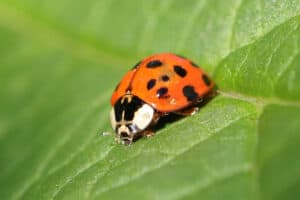Ladybugs, also known as lady beetles or ladybird beetles, or by their scientific name Coccinellidae, are a welcome sight in gardens due to their propensity for devouring pests that are harmful to plants. However, they become less endearing when they infiltrate homes in large numbers. So the big question is, how do you get rid of ladybugs inside your home?
In this article, we will cover natural, eco-friendly ways to evict these uninvited guests without causing harm to them or the environment, why and how ladybugs infest homes, the best solutions to how to keep ladybugs out of your home, and the important role these beetles play in the Earth’s ecosystem.
So, let’s get started!

Ladybugs swarm homes in the fall seeking shelter from cold weather.
©Millie Bond – Copyright A-Z Animals
It’s Important To Understand The Full Picture
When getting rid of ladybugs inside your home, it’s important to know how they got there in the first place, as this will aid in preventing their return. Ladybug infestation causes can be due to a number of influences.
They usually seek shelter inside homes during the fall or winter when outside temperatures begin to drop. They are attracted to light-colored homes, typically those in a forested area, sunlit and older, as these conditions often offer more crevices and hiding places. The ladybugs infiltrate the house through small openings around door and window frames, utility wires, and such. Once inside, they hibernate until spring’s warmer temperatures, when they become active again and try to exit, often without success.
Ladybug infestations are particularly common in temperate and subarctic regions, where these insects seek refuge from harsh winter conditions. In the fall, North America, particularly the Midwest and northeastern regions, often experiences ladybug infestations. In parts of Europe, such as the United Kingdom, ladybugs often swarm at-risk houses during the autumn in large numbers.
How Can You Get Rid of Ladybugs Inside Your Home?
While ladybugs may be considered a source of good luck in many cultures and are generally beneficial insects that do more good than harm, they can be a bother when infiltrating our homes. Natural methods, both homemade remedies and commercial products, are available to manage ladybug infestations without harming these useful insects or the environment but still getting rid of them in your home. Furthermore, we will discuss methods and products in detail later; it’s worth noting that they primarily involve deterring ladybugs from entering in the first place or, if they’re already inside, humanely trapping and releasing them outside.
When it comes to preventing ladybugs from targeting homes, there are several measures homeowners can take. These include sealing off entry points, using certain natural repellents, and maintaining a clean and uncluttered home. It’s important to remember that you should implement these measures before the onset of colder weather when ladybugs start looking for places to hibernate.
Ladybugs Are Not Harmful

While ladybugs in your home may be a nuisance, they are not harmful.
©Natasha Zakharova/Shutterstock.com
Ladybugs pose little to no direct threat to humans or pets. They do not transmit diseases, bite, or sting. Some people may experience a mild allergic reaction to the yellowish secretion that ladybugs release when threatened, but such occurrences are rare. However, they can become a nuisance in large numbers due to their odor and staining from their secretions. Despite the inconvenience caused by ladybugs infesting homes, these beetles play a vital role in our ecosystem. They are biological control agents, feeding on aphids, mites, and other small insects that harm crops and gardens, reducing the need for harmful pesticides.
Now, let’s dive into how to get rid of ladybugs with home remedies and commercial products to remove these unwanted guests from our homes.
14 Home Remedies and Products to Get Rid of Ladybugs From Your Home
Once ladybugs have already established residence in your home, evicting them can be quite the task. However, with a few thoughtful measures, it’s possible to handle this situation in an environmentally friendly way, causing minimal harm to these beneficial insects while protecting your home from their presence.
Identifying their primary hiding spots is the first step in getting rid of ladybugs from your home. These insects often congregate in warm and bright areas, such as windowsills, light fixtures, and wall corners. Look for them in attics, wall voids, and cracks and crevices around windows and doors. The second step is removing them!

Ladybugs are not harmful to homes, but there are natural products to remove them effectively.
©Michal Kimmel/Shutterstock.com
In line with a natural approach, here are 14 non-toxic strategies and products to consider:
1. Vacuuming
Perhaps the simplest method allows for the gentle collection of ladybugs. To ensure the bugs remain unharmed during the process, consider using a soft brush attachment or placing a nylon stocking inside the vacuum cleaner’s hose to catch them. Once collected, they can be released outdoors, away from the home. Highlighting the fact that effective pest management can indeed be humane.
Vacuuming is often used in tandem with another method to remove a large number of ladybugs at once.
2. Diatomaceous Earth (DE)
Diatomaceous Earth, or DE, is a non-toxic substance made from fossilized aquatic organisms. It acts as an effective deterrent when sprinkled around infested areas.
To use this method, do as follows. Simply use your hands or a duster and lightly dust the DE in areas where you’ve seen ladybugs or think they might enter, like near doors, windows, or other openings. A thin, barely visible layer is sufficient. Reapply the DE every few days or after cleaning, or anytime it gets wet, as it’s not effective when wet.
While harmless to humans and pets, ladybugs are repelled by the powder due to its drying, abrasive nature. Use food-grade DE, as other forms can be harmful if inhaled or ingested.
3. Citrus or Clove Oil Spray
Ladybugs display a natural aversion to citrus and clove scents.
To create a citrus and clove oil spray for repelling ladybugs, do as follows. Fill a spray bottle with water. Add 10-20 drops each of citrus (e.g., lemon or orange) and clove essential oils. Shake the bottle well to mix the oils with the water. Then spray around ladybug entry points, always in a well-ventilated area.
Applying this mixture to areas frequented by ladybugs can deter them from settling and is one of the best solutions how to get rid of ladybugs in window frames.
4. Light Traps
Ladybugs are attracted to light, and this trait can be capitalized by trapping them using commercially available light traps. These traps emit warmth and light, which attract ladybugs and trap them inside. This allows for easy collection and release back into the environment.
5. Camphor and Menthol
The strong smells of camphor and menthol can effectively repel ladybugs. Placing a few drops in infested areas can help to discourage the insects from settling.
Another recipe would be to place a few camphor tablets or a teaspoon of camphor crystals and a similar amount of menthol crystals into small open containers or sachets. Distribute these containers or sachets around your home, especially near doors and windows.
Be aware that the strong smell can irritate some people and pets, and always keep them out of reach of children and pets.
6. Homemade Traps and Sprays
You can create a homemade trap by filling a jar with a few drops of liquid dish soap and one cup of water. Shake the jar and illuminate it with a lamp. The ladybugs are attracted to the light, fall into the jar, and are trapped.
Likewise, you can create a simple mixture of a few drops of liquid dish soap and one cup of water in a spray bottle and spray directly on the ladybugs to deter them. The soapy water is harmless to humans and pets but can disrupt the ladybugs’ movements, encouraging them to leave.
7. Chrysanthemums
These flowers produce pyrethrum, a natural insecticide that can deter ladybugs.
To create a natural insecticide from chrysanthemums, do as follows. Simmer one to two cups of fresh chrysanthemum flowers in one to two liters of water for 30 minutes. Let the mixture cool. And then strain it to remove the flowers. Pour the remaining liquid into a spray bottle.
Spray this solution around areas where you’ve noticed ladybugs, testing it on a small area first to ensure it doesn’t cause any damage or discoloration. However, use caution with this method as it can harm beneficial insects, so it should be used sparingly and only when necessary.
8. Neem Oil
Neem oil is an organic compound that can deter ladybugs and other pests.
A simple recipe would include mixing one liter of water, one teaspoon of neem oil, and a few drops of liquid dish soap in a spray bottle. The dish soap is not necessary, but it does help to emulsify the oil in the water and allows it to stick to surfaces better.
Remember to shake the spray bottle before each use to ensure the oil is well mixed with the water. Also, keep in mind that while neem oil is non-toxic to humans and pets, it can harm certain beneficial insects and aquatic life. Therefore, use this spray with good judgment and try to limit its use to indoor areas.
9. Indoor Bug Zappers
While not the first choice due to their lethal nature, you can use indoor bug zappers as a last resort. These devices lure ladybugs with light and then exterminate them with a small electrical charge.
10. Herbal Sachets
Ladybugs dislike the scents of certain herbs, such as bay leaves, cloves, rosemary, and mint.
A recipe would include as follows. Fill small fabric sachets or homemade cheesecloth pouches with a mixture of these dried herbs. Measuring roughly two to three tablespoons per sachet. Set these sachets in areas where you’ve noticed ladybugs or where they might enter your home, such as near doors or windows.
Placing sachets filled with these herbs in areas where ladybugs congregate can effectively discourage them from settling in your home and leave the space smelling fresh and clean.
11. Vinegar Spray
A solution of distilled white vinegar and water can serve as a safe and natural deterrent when sprayed in areas where you find ladybugs. While vinegar doesn’t kill ladybugs, the strong smell of vinegar is unappealing to them and many other insects.
A simple recipe includes a 1:1 ratio of vinegar and water.
However, remember that vinegar is an acid and can potentially damage certain materials, so be careful when applying it. Always do a spot test first, and avoid using it on delicate items, natural stone surfaces, or wood that acids can easily damage.
12. Caulking and Sealing
An effective long-term strategy to prevent ladybugs from entering your home involves sealing off potential entry points, including cracks, gaps, and crevices in walls, windows, and doors. Use caulk or other suitable sealants to block their access effectively.
13. Insect Screens
Installing insect screens over vents, windows, and other openings can provide an additional layer of protection against ladybugs entering your home.
14. Professional Pest Control Services
If the infestation is too large to manage, consider contacting a professional pest control service. Many services now offer eco-friendly solutions that can effectively deal with a ladybug infestation while minimizing harm to the environment, your family, and the bugs themselves.
When searching to hire a pest control service, look for certificates such as GreenPro, EcoWise, or Green Shield. These certificates show that the service adheres to specific standards of environmental responsibility.
Once you are ready to reach out to potential services, ask about their pest control methods and the products they use. A truly eco-friendly service should prioritize integrated pest management (IPM) strategies, which focus on long-term pest prevention through a combination of techniques such as biological control, habitat manipulation, and modification of cultural practices.

Ladybugs are gardeners’ best friends as they eat lots of pesky bugs that damage plants.
©iStock.com/Henrik_L
Ladybugs are Essential to the Environment
With their vibrant colors and distinctive spots, these beetles are widely appreciated for their beauty and ecological value. They are essential in controlling harmful garden pests, such as aphids, making them gardeners’ best allies. Nevertheless, when they invade our homes in search of shelter, we face the challenge of relocating these beneficial creatures without causing them harm. Approaching this task with an understanding of the ladybugs’ ecological significance is crucial.
In the context of our homes, ladybugs, although harmless, can become a nuisance when they appear in large numbers. It’s important to remember that their appearance indoors is often a response to environmental cues, such as changing seasons, rather than a deliberate invasion of our space. These beetles are simply seeking a warm, safe place to overwinter, and our homes can inadvertently provide the perfect refuge.
Getting Rid of Ladybugs From Your Home Doesn’t Have to be Harmful or Toxic
However, cohabiting with a swarm of ladybugs is not a practical or desirable solution for most homeowners. The challenge, therefore, lies in balancing our need for a bug-free home with respect for these insects’ vital role in our ecosystem. This delicate balance calls for removal methods that are both effective and considerate of the ladybugs’ welfare.
The natural, non-toxic strategies available for this purpose reflect an increasing recognition of the need for humane and eco-friendly pest control solutions. Such methods focus on deterrence and relocation, guiding ladybugs back to their natural habitat rather than resorting to harmful chemicals or lethal tactics. While preventive measures can significantly reduce the likelihood of a ladybug invasion, they are not always foolproof.
In such cases, the focus should shift from prevention to effective management. Always with the goal of minimal harm to the ladybugs and the environment. Professional pest control services, which now often offer eco-friendly solutions, can also provide valuable assistance in managing larger infestations. Even in these circumstances, the emphasis should be on relocating the ladybugs safely rather than exterminating them.
Conclusion
The methods mentioned above provide humane ways to get rid of ladybugs inside your home, ensuring a win-win situation for both homeowners and ladybugs.
Managing ladybug invasions in our homes calls for a thoughtful and conscientious approach. Recognizing these beetles’ important ecological role can help guide our actions, prompting us to choose methods that prioritize their welfare. By doing so, we maintain the balance of our local ecosystems and contribute to a broader shift towards more humane and environmentally responsible pest management practices.
The photo featured at the top of this post is © Henri Koskinen/Shutterstock.com
Thank you for reading! Have some feedback for us? Contact the AZ Animals editorial team.







